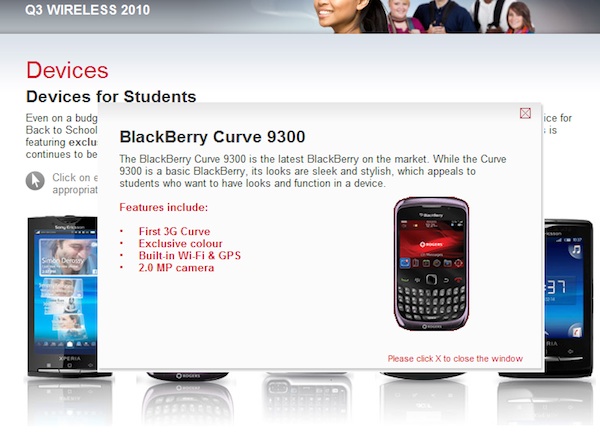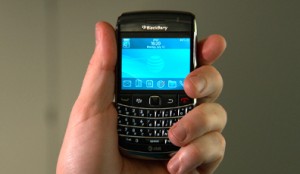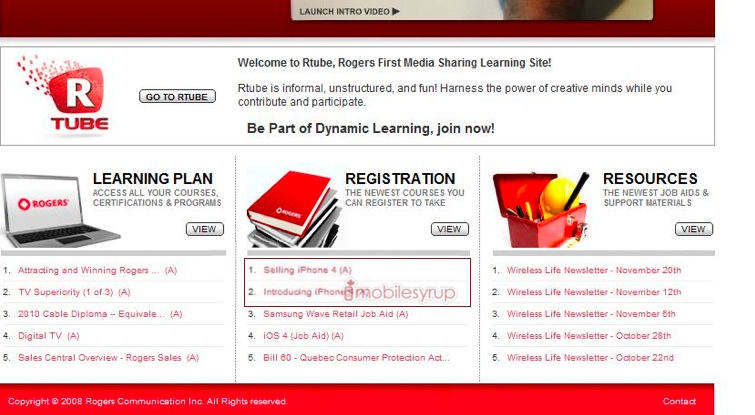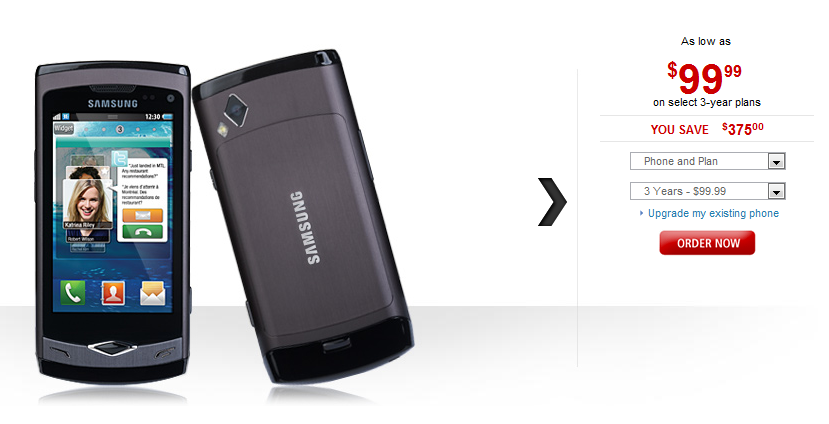Follow me on TwitterRSS Feeds
Rogers Wireless
Blackberry Curve 9300 3G Headed To Rogers
Jul 20th

We told you yesterday that Bell was planning on launching the Blackberry 9300 on their HSPA network near the end of the year. Now comes word by ways of Crackberry that Rogers intends on launching it as well; in an exclusive Grey or Violet variety. As you see by the above flyer, they intend on launching it during Q3 or “Back to school” time and my assumption is that it will be under $50 on a 3 year term (perfect for students on a budget). Again, there is no word on exact pricing or release date, but expect to hear more as the summer ends.
[Via Crackberry]
Follow me on twitterCanadian Carriers Most Profitable In Developed World
Jul 20th
 An interest study just emerged confirming what most Canadians already know: their big three carriers are the most profitable in the developed world. According to Bank of America Merrill Lynch, Rogers, Telus and Bell combined for an average of 46.7% profit in the first quarter of this year. Compare that with the UK carriers of 22.6%, which is because of a strong competitive market. Canadians also paid $54.73 US/month on average, also the highest in the developed world.
An interest study just emerged confirming what most Canadians already know: their big three carriers are the most profitable in the developed world. According to Bank of America Merrill Lynch, Rogers, Telus and Bell combined for an average of 46.7% profit in the first quarter of this year. Compare that with the UK carriers of 22.6%, which is because of a strong competitive market. Canadians also paid $54.73 US/month on average, also the highest in the developed world.
Hate to say it, but us Canadians know this without even reading the report. Cell phone cost of ownership, especially with three-year contracts for data and voice, is extremely high. Rogers has often justified their high costs by claiming that to roll out a large-scale 3G network to a country the size of Russia and a population half that of Italy is extremely costly. But how costly, exactly? Consumers in Greece only pay an average of $19.87.
Other interesting stats:
- Canada’s penetration rate is only 69%
- Canada still has the highest rate of landline phone use in the world
- Canadians are the third most talky nation with the average person talking 368 minutes per month
- Korea is second with 374 and the US leads with 814(!!) talk minutes every month
(via CBC News)

This Week In BlackBerry 4/11-4/17
Jul 18th
BlackBerry leaks have been very light this week, but RIM has really picked up the slack with their official presence. The new BlackBerry 6 teaser video, BBM commercials and RIM’s Annual General Meeting definitely kept us entertained throughout the week.
Just when everything was calm again, Steve Jobs brought BlackBerry news back to life by attempting to pull RIM into Apple’s faulty antenna situation. Mike Lazaridis and Jim Balsillie usually aren’t the type to respond to other Smartphone companies, but in this case, they felt it was necessary to put Steve Jobs in his place. Antennagate is so newsworthy, even people who normally don’t follow Smartphone news were talking about it and passing phones around, attempting to ‘death grip’. Hit the jump to see what you may have missed this week in BlackBerry.
News
RIM Releases Another BlackBerry 6 Teaser Video
RIM Finally Starting To Push BBM Through TV Commercials
BlackBerry 9800 Slider Parts Starting To Surface
Another Year, Another RIM-shot
Bell Dropping the Blackberry Bold 9000?
Blackberry 9800 To Be A Rogers Exclusive?
Apps
Bolt Browser updated to v2.11 fix a major bug!
Editorials
Viigo app to become a thing of the past?
Accessories
BlackBerry Accessory Review: Otterbox Commuter Case for Bold 9700
Is the iPhone 4 really defective or is it just AT&T?
Jul 13th
When Rogers launched the iPhone 3G in July of 2008 their network must have been beaten to a pulp. They were the only network in Canada with iPhone for over a year, and until Bell and Telus launched their HSPA+ network in late 2009, Rogers seemed poised for a network over-extension. Recently Toronto saw Rogers’ network crack under the weight of the Pride Parade and a million visitors descending on the downtown core. It was not a good day for the network, and I have no doubt that Americans feel similarly perturbed on a daily basis when waking with AT&T’s spotty service.
But where we’ve heard the most chatter from iPhone 4 users about reception problems is in the US. A country with a network problem as it stands. Rogers rarely has signal degradation on their 3G network, and it will be interesting to see how the carrier handles the extra load when thousands of people inevitably sign up new contracts for the iPhone 4.
Suffice it to say, the antenna design was not an afterthought. If AT&T had a better network with a more pervasive 3G signal, this would be a non-issue. Merely covering the antenna does not always end in dropped calls and signal degradation, but when the signal is already low, it may lower it to a breaking point. There is a distinct difference between a design flaw and a co-dependance problem. Apple relies on its carriers to supply the data routing and signal availability. AT&T may have over-promised when they renegotiated with Apple to continue their exclusivity contract. No one really knows at this point. What we do know is that Apple is taking a lot of heat for this problem, and they may not be the right giant corporation to be pointing fingers at.
Then again, maybe they are.
As of today, the share price has taken quite a beating, losing about $9 billion in market share. That is peanuts in the scheme if things for Apple, but try to remember the last time the company was in hot water for one of their products? Doesn’t happen too often. I am no fanboy, and I hope the company learns a lot of lessons from this debacle, but let’s be clear here. A lot of engineers have claimed that the antenna, when receiving a strong signal, is actually much better than any previous iPhones. This is a fact. The fiction is the “improvements” AT&T seems to be making to their network.
Facts? Facts don’t sell phones.
Price Drops Coming For Rogers Android Handsets
Jul 12th
Rogers is usually pretty competitively priced with their phones. They can have such large subsidies because in Canada, with three-year contracts, they are guaranteed a certain amount of revenue per customer. And Rogers’ monthly charges, especially for a smartphone, are not cheap.
So a few handsets are coming down in price, and while none are earth-shattering, they bring the devices down to a certain level where, when the iPhone 4 arrives, they will still be attractively and competitively priced.
![]() Firstly, the Sony Ericsson Xperia X10 is coming down in price from $149.99 to $99.99. This is a very nice Android handset that has just received a nice little upgrade to improve performance and battery life, though in reality if it’s not Android 2.1 no one really wants it.
Firstly, the Sony Ericsson Xperia X10 is coming down in price from $149.99 to $99.99. This is a very nice Android handset that has just received a nice little upgrade to improve performance and battery life, though in reality if it’s not Android 2.1 no one really wants it.
The Motorola QUENCH and Acer Liquid e are both coming down from $49.99 to $29.99. These are capable phones, but I would take the Acer over the QUENCH, since the specs are much better and the screen is gorgeous, and it currently runs Android 2.1 while the QUENCH runs Android 1.5 on top of Motorola’s MOTOBLUR skin, which is great for quick messaging and terrible for everything else.
The long-in-the-tooth Samsung Galaxy Spica is coming down from $29.99 to $9.99. This is also a nice phone, great specs and is very hardy, but is still running Android 1.5! So the faster this phone gets off the market, the better for Android fragmentation.
![]() And lastly, the brand-newly launched Samsung Wave is already receiving a price cut, from $99.99 to $79.99. This phone runs on Samsung’s own bada OS, and has not really been proven to give any advantage over existing platforms. Read my editorial on why the Wave will likely flop in Canada (and elsewhere).
And lastly, the brand-newly launched Samsung Wave is already receiving a price cut, from $99.99 to $79.99. This phone runs on Samsung’s own bada OS, and has not really been proven to give any advantage over existing platforms. Read my editorial on why the Wave will likely flop in Canada (and elsewhere).
Remember, all these prices are for new customers who sign a three-year contract. So take that into account when buying a phone you are likely going to spend a lot of time with over the next three years.
iPhone 4 Training Has Started At Rogers
Jul 12th

Although the release date is up in the air, the Rogers online training deck called “Fast Track” has recently been updated to include how to sell the iPhone 4 and a short introduction to the new device for employees to start testing on.
Could this mean Rogers is still on track for an end of July release? Nothing is certain, but it is exciting news for both Rogers iPhone users anxious to get their upgrade and Blackberry users patiently waiting to take the leap.
[Via MobileSyrup]
Follow me on twitter
The Battle For Canada: Chat-r vs Wind vs Mobilicity vs itself
Jul 9th
Is it fair that Rogers, the established giant of mobile dominance in Canada, and especially in Toronto, is launching a discount brand, Chat-r, to compete directly with the two newly-launched, low-cost providers in WIND Mobile and Mobilicity? John Bitove, Chairman of Mobilicity, doesn’t seem to think so.
After learning of Rogers’ intention to squarley aim for the the small companies’ bottom lines, he has filed a complaint to the Canadian Competition Bureau. “They’re trying to destroy our success,” he said to the Globe and Mail. Not surprisingly, Mobilicity is less keen than WIND to see Rogers attempt to eat into their limited market penetration, as the company only officially launched in May of this year. WIND has been around for almost a year now, and, while not the run-away success story that many hoped it would be, has certainly created a new sense of urgency in the Canadian mobile market for fairer prices and more included features. With unlimited internet usage, and low talk-and-text plans, WIND and Mobilicity have aimed themselves at urbanites who don’t need a great number of features on a phone, as well as new immigrants, who want cheaper ways to call back home. Chat-r does not intend to offer data connectivity with their talk-and-text plans, though those will be unlimited.
A few days ago, Anthony Lacavera stated that Chat-r is exactly what this country needs: more competition. On a BNN news segment, he said that Chat-r is “great for consumers… the big guys are starting to react, and the more they react, the better we look.” This heavily contrasts Bitove’s view, and brings home the idea that WIND, with their Egyptian financial backers, Orascom Telecom Holding, seem more capable of weathering out the short-term growth issues than does Mobilicity. Certainly, Rogers is going to have a much easier time than either WIND or Mobilicity in bringing Chat-r to the market, since they are providing similar service and similar prices without having to build an entirely new network infrastructure to it; instead, they are piggy-backing off existing Rogers towers in the same locations that the former carriers have launched in: Toronto, Calgary, Ottawa, Edmonton and Vancouver.
I don’t necessarily see Chat-r as a full-fledged success from the get-go. Sure, Rogers is going to leverage its own brand when advertising it, unlike with Fido which operates completely independently of its big brother. But with the knowledge that Chat-r is owned by Rogers will also come the understanding that it is not the nimble, young company that WIND is, nor the forward-looking enterprise that is Mobilicity. It’s Rogers under a new banner, and for some people, especially those that have been burned by the company in the past, Chat-r must be a huge turn-off.
Rogers to Sponsor Cirque Du Soleil for the 2010-2011 Season
Jul 9th

The Rogers Wireless name is synonymous with innovation in Canada; Cirque Du Soleil has become a notorious global brand with shows spanning the globe, acrobats consistently pushing creative boundaries, and roots also originating in Canada. This being said it would make sense that these two benchmarks in Canadian history find some common ground and do something spectacular together.
This morning it was announced that Rogers will be the new sponsor for Cirque Du Soleil’s 2010-2011 season, beginning tonight with special showing of the act “TOTEM” in Montreal’s old port.
Cirque Du Soleil’s President and CEO Daniel Lamarre had this to say:
“In the past, Rogers provided us with very innovative wireless solutions. Rogers is now the official sponsor of our 2010-2011 Canadian Tour. We are confident that Rogers will provide the necessary support to increase the reach of our shows and our artists across the country.”
Rogers plans on leveraging this partnership by encouraging customers to buy tickets through their proprietary wireless box office and other mobile online platforms to be announced at later dates.
Read the official press release here.
[via CNW]
Follow me on twitterDoes Bada have a place in the Canadian market place?
Jul 8th

Today, Rogers Wireless announced the immediate availability of the Samsung Wave, the cousin to the Galaxy S series running its own Bada operating system instead of Android. While not a lot of good things have been said about the Bada platform, especially when compared to the robust existing offerings from Apple, Google and RIM, its mere existence brings home the point that phone manufacturers, from Samsung to HTC, are seriously considering branching into independent software platforms to embed onto their hardware.
But where is the value here for Samsung? Developers will likely balk at the idea of developing for yet another mobile platform, especially after realizing that it is a lot harder to make money off their apps than they first considered. Yes, especially in the App Store, there are tons of success stories, but for every one that succeeds there are many that don’t.
Perhaps then it is in the value of a closed ecosystem for the company. Designing both the hardware and software allows them complete control over how the phone interacts with the OS. They have seem Apple’s success with this; the opportunities for in-app advertising as well as product tie-ins are quite attractive. And if the Bada platform can be expanded to work on tablets, microwaves, printers… the opportunities are seemingly endless.
But there are also tons of ways to fail here. Without robust first-party capabilities, Bada doesn’t stand a chance of luring people away from the Apple monster. Without extensive HTML5 support or a deep app store, why pay $99 for a Samsung Wave when the 8GB iPhone 3GS is the same price with the same carrier.
The hardware on the Wave seems good. 3″ Super AMOLED 800×480 screen, 1GHZ Hummingbird processor, 5MP camera, WiFi, GPS. But good specs are no longer good enough to take people away from what they know.
And Rogers, pricing the device at $99, is positioning it in the smartphone category. Not smart. I will reserve final judgment, however, until I have used the device, and you can expect a review here soon.
For more info, check out Rogers’ site: Samsung Wave









Interact With Us